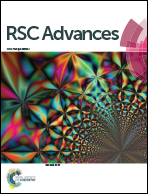Ultra-sensitive detection of heparin via aPTT using plastic antibodies on QCM-D platform
Abstract
One of the challenges faced by today's clinics is unavailability of practical, precise and accurate determination of the most commonly used anti-coagulant ‘heparin’ in human blood/plasma in surgery. This is the first report of the application of a heparin imprinted thin film on a Quartz Crystal Microbalance with Dissipation (QCM-D) platform. Based on a novel, straight-forward and robust imprinting approach, a lowest volume consumption of 2 μL of real sample (of human plasma) has been demonstrated. This is a leap for launching spot testing for heparin sensing in laboratory practice. This approach could shorten the coagulation times to 48% and 45% for clinically important sensing range of heparin doses of 0.75 and 0.50 IU mL−1 respectively and could improve precision 3-fold (n = 20 samples) compared to that of today's 'gold standard'. Activated partial thromboplastin time (aPTT) on the plastic antibodies based QCM-D platform for plasma with doses of heparin 0.75 IU mL−1 and 0.50 IU mL−1 yielded 6.5% and 5% lower %RSD respectively as compared to that of the ‘gold standard’. The present studies could provide a launch pad to laboratory methods for ultra-refining of point of care (POC) settings in the perspectives of coagulation time shortening, precision of the method and sample volume consumption.


 Please wait while we load your content...
Please wait while we load your content...